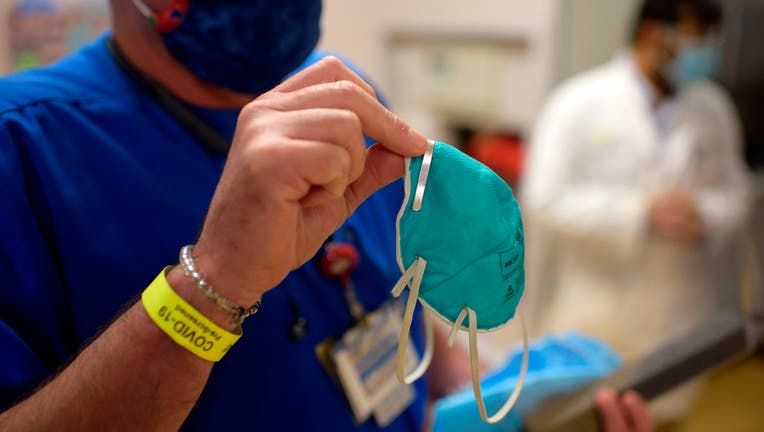Researchers test 14 types of face masks to see how well they protect against COVID-19

FILE - A medical worker holds up an N95 mask in the ER at Oakbend Medical Center in Richmond, Texas, on July 15, 2020.
LOS ANGELES - While health officials and government leaders are advocating and even requiring individuals to wear masks in public amid the pandemic, a new article suggests that some masks, particularly a fitted N95 mask, may be more effective in helping prevent the spread of COVID-19 than others.
Published on Aug. 7 in Science Advances, the article describes how it is assumed that, in general, wearing a mask can help prevent the spread of the novel coronavirus, but many mask designs themselves have not been tested in practice in regards to their efficacy.
Researchers tested 14 available masks or mask alternatives, as well as a patch of mask material and a professionally fitted N95 mask. Among the 14 masks tested were surgical masks, a bandana, a valved N95 mask, as well as different types of cotton-based masks.
There has been a high demand for N95 masks in particular from health care workers since the onset of the pandemic. “An N95 mask offers more protection than a surgical mask does because it can filter out both large and small particles when the wearer inhales,” the Mayo Clinic said. “As the name indicates, the mask is designed to block 95% of very small particles.”
When testing the masks, researchers recorded control trials in which the speaker wore no protective facial covering.
“Each test was performed with the same protocol. The camera was used to record a video of approximately 40 s length to record droplets emitted while speaking,” according to the article.
“The first 10 s of the video serve as baseline. In the next 10 s, the mask wearer repeated the sentence ‘Stay healthy, people’ five times (speech), after which the camera kept recording for an additional 20 s (observation). For each mask and for the control trial, this protocol was repeated 10 times,” the article reads.
After conducting the recordings, the researchers used a computer algorithm to count the number of particles in each video, determining the relative droplet count for each mask. A graph accompanying the article shows both the mean and standard deviation over 10 trials for the same mask, “normalized to the control trial (no mask), and tested by one speaker.”
According to the graph, the fitted N95 mask appears to be associated with a lower droplet count than any of the other masks, followed then by the surgical mask and the Cotton-polypropylene-cotton mask.
“We compared a variety of commonly available mask types and observed that some mask types approach the performance of standard surgical masks, while some mask alternatives, such as neck fleece or bandanas, offer very little protection,” according to the article.
RELATED: Moderna details coronavirus vaccine pricing as orders roll in
The researchers also said, “In the case of speaking through a mask, there is a physical barrier, which results in a reduction of transmitted droplets and a significant delay between speaking and detecting particles. In effect, the mask acts as a temporal low pass filter, smoothens the droplet rate over time, and reduces the overall transmission.”
The researchers said the droplet rate for the bandana was merely reduced by a factor of two during tests, while the effect of the cotton mask was more significant.
“Furthermore, the performance of the valved N95 mask is likely affected by the exhalation valve, which opens for strong outwards airflow,” the article read. “While the valve does not compromise the protection of the wearer, it can decrease protection of persons surrounding the wearer. In comparison, the performance of the fitted, non-valved N95 mask was far superior.”
The researchers also discussed some of the limitations of their study, including that some droplets may not have been registered in the laser beam and that the use of a cell phone camera poses limitations on detection sensitivity.
“We should point out that our experiments differ in several ways from the traditional methods for mask validation, such as filtration efficiency of latex particles,” the researchers said. “As is apparent from the neck fleece study, liquid filtration (and subsequent particle size reduction) are more relevant than solid filtration. In addition, our method could inform attempts to improve training on proper mask use and help validate approaches to make existing masks reusable.”


